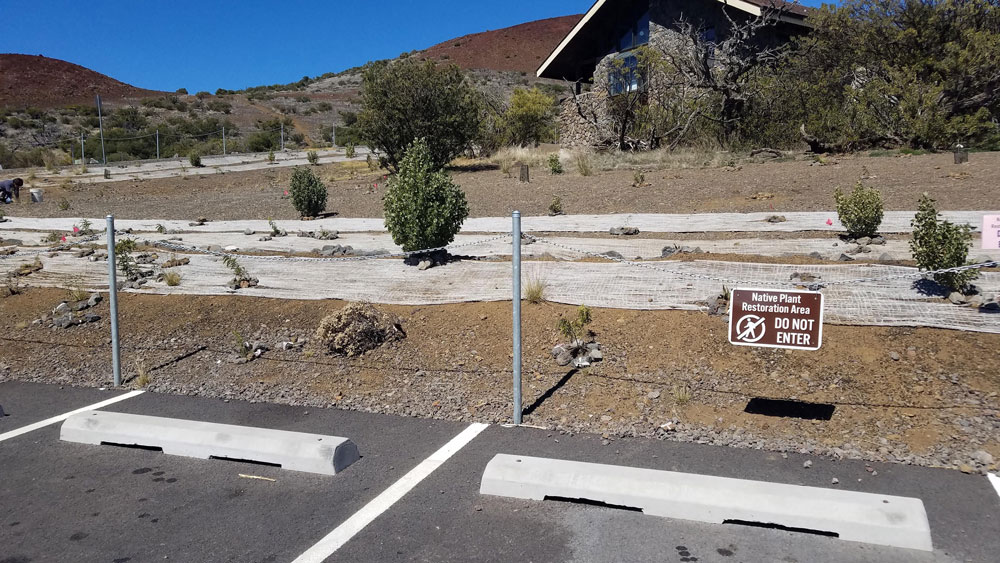Native Plant Restoration Efforts Progressing on Maunakea

Native plants are now flourishing at the Maunakea Visitor Information Station, nearly two years after plant restoration efforts to replace māmane trees and enhance the subalpine ecosystem began.
The Center for Maunakea Stewardship has managed to establish māmane and other native plants including ʻāweoweo, pawale, puakala and heʻupueo, a native grass, to enhance the native ecosystem at the VIS, which is at the 9,000 foot elevation of Maunakea.
CMS’ restoration efforts are aimed at fulfilling its commitment to establish at least two māmane trees for every tree that was removed for the Visitor Information Station parking lot improvement project. The project ensures parking and vehicle pullouts are on the same side of the road as the Visitor Information Station, which will provide safe public access as required by the Maunakea Comprehensive Management Plan.
“Ongoing work to revive and expand the population of native plants on the mauna is just one of the many areas of stewardship the University of Hawaiʻi is committed to fulfilling,” said CMS Executive Director Greg Chun. “From caring for natural and cultural resources, telescope decommissioning and public access management, CMS is privileged to have the opportunity to enhance UH’s stewardship of Maunakea.”
Jessica Kirkpatrick is CMS’ natural resource specialist and leads efforts to protect flora and fauna on Maunakea. The center’s restorative work is contributing to larger efforts on the mauna to provide habitat and resources for the palila, an endangered Hawaiian honeycreeper and other native birds and arthropods unique to the subalpine ecosystem. The palila bird depends on māmane trees for survival and reproductive success and are currently restricted to a tiny patch of māmane habitat (~ 25 square miles) on the upper slopes of Maunakea.
More than 400 keiki (young) māmane trees can be observed around the VIS where construction occurred to improve the parking lot. The nitrogen fixing tree with yellow pea-shaped flowers is endemic to the main Hawaiian Islands and although it once thrived in forests from mauka to makai, it is currently limited to sub-alpine environments on Maunakea and Maunaloa on Hawaiʻi Island. More than 50% of the trees have sprouted up on their own as a result of natural regeneration and invasive weed management.
“We hypothesize that māmane are naturally regenerating in the restoration area because we keep these areas free of invasive weeds which gives these plants a chance of survival without competing for resources,” Kirkpatrick explained. “We also work to prevent the establishment of new invasive species on the mountain such as ants. All ants are introduced to Hawaiʻi and when they become established in our native ecosystems, they can have detrimental impacts to ecosystem function and contribute to species extinction. Maunakea is the only place in the state that does not have ants, and keeping it that way allows these endemic plants and arthropods that are host specific to these plants to thrive.”
CMS’s plant restoration process starts with collecting seeds from established native plants in the area. Some seeds, like māmane, need to be scarified and soaked before they are planted. Once plants are large enough they are outplanted into the natural environment and watered until they become established. It is critical to use soil exclusively from Maunakea to prevent the spread of invasive species. CMS must also remove invasive weeds, such as fireweed, telegraph weed, pin clover and mullein on a daily basis to give the native plants a chance to survive.
Due to the COVID-19 pandemic, volunteer opportunities to help with restoration efforts were canceled. There has been no decision at this time on when volunteer groups can return. Since 2012, more than 1,100 volunteers have filled close to 2,000 garbage bags with invasive weeds pulled from the Halepōhaku area. One of the goals of the restoration area is to have community volunteers and school groups help with the entire restoration process to provide educational opportunities and a pilina (relationship) with the management of Maunakea.













